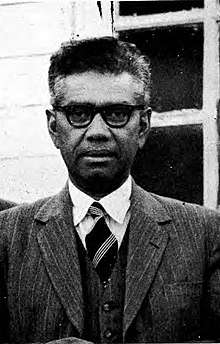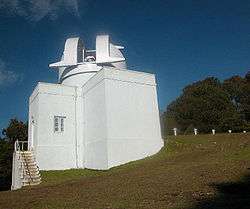Anil Kumar Das
Anil Kumar Das FRAS, FNI (1 February, 1902 - 18 February, 1961) was an Indian scientist, astronomer. During the International Geophysical Year, observatories in Madrid, India, and Manila were responsible for monitoring solar effects. The Kodaikanal Solar Observatory in South India performed this monitoring using their recently built solar tunnel telescope. Dr. Das was the director of the Kodaikanal observatory at this time. In 1960 he was responsible for installing a tower/tunnel telescope at the facility that would be used to perform some of the first ever helioseismology investigations.[1] The crater Das on the far side of the Moon is named after him.[2]
Padma Shri awardee Anil Kumar Das | |
|---|---|
 Prof. Anil Kumar Das | |
| Born | 1 February 1902 |
| Died | 18 February 1961 (aged 59) |
| Alma mater |
|
| Known for |
|
| Awards |
|
| Scientific career | |
| Fields | |
| Institutions |
|
| Academic advisors |
|
| Signature | |
 | |
Biography

After graduating ( Master of Science ) from the University of Calcutta, he studied spectroscopy with Charles Fabry at the Sorbonne in Paris. After obtaining his doctorate he was in Göttingen where he worked with Max Born at the Institut für Theoretische Physik and subsequently with Gustav Augenheister at the Geophysikalisches Institut and for a short period at the Solar Physics Observatory in Cambridge . He later worked at the Indian Meteorological Department in 1930 and then moved to the Kodaikanal observatory in 1937 as assistant director and director since 1946 and where he remained until his retirement in 1960.[3][4]
Scientific contributions
Most of his scientific contributions were in the field of solar physics mainly as an experimenter in the spectrophotometric study of sunspots and the chromosphere . He contributed significantly to the development of the equipment present at the Kodaikanal Observatory and to the growth of numerous young researchers.[3]
Award and Honors
- Fellow of the Royal Astronomical Society in 1935
- Fellow of the National Institute of Sciences of India
- The lunar crater Das (crater)[2] dedicated to him by IAU
- Padma Shri by Indian government[4]
External links
References
- Bappu, M.K.V. (June 2000). "The Kodaikanal Observatory - A Historical Account". Journal of Astrophysics and Astronomy. Bangalore: Indian Academy of Sciences. 21 (3–4): 105. Bibcode:2000JApA...21..103.. doi:10.1007/bf02702374.
- "Cratere Das". Gazetteer of Planetary Nomenclature. USGS Astrogeology Research Program.
- Mitra, S.N. (July 1961). "Obituary: Dr. A.K. Das (1902-1961)" (PDF). Journal of the IETE. 7 (4): 1–6. hdl:2248/1704.
- Bappu, M.K.V (March 1961). "Obituary notices: Anil Kumar Das" (PDF). The Quarterly Journal of the Royal Astronomical Society. 2 (4): 278–279. hdl:2248/1701.